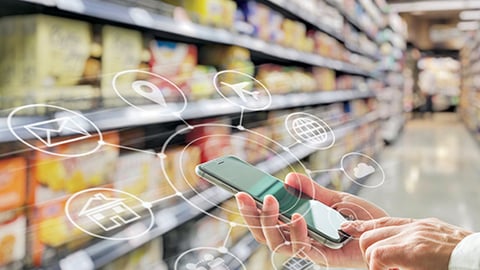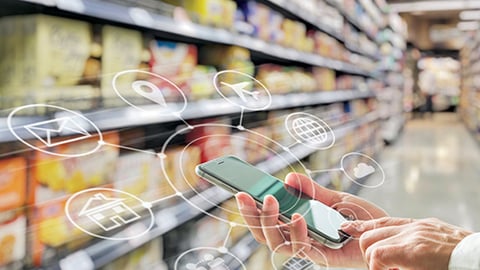CGT Roadmap: The Journey to Trade Promotion Excellence
With the numerous transformational changes taking place across the industry, you would think that a business practice representing as much as 20% of a consumer packaged goods company’s total revenue and as much as 60% of its total marketing spend would be at the top of the list for an overhaul. But you’d be wrong.
An unprecedented level of change is moving the CPG industry toward digital marketing, e-commerce and even direct-to-consumer sales. Yet traditional brick-and-mortar stores still represent more than 90% of product sales in nearly every packaged goods category.
Correspondingly, spending on trade promotion — the financial fuel that has driven marketing at retail for decades — still represents the second largest line item on the ledgers of most CPG companies, with more than $500 billion spent annually around the world.
Historically, the internal processes of trade promotion management and, more recently, trade promotion optimization, have sought to improve the practice and alleviate many of the issues that CPGs have historically faced by letting them track spending and ROI, compare activity and share best practices across retail accounts, and plan more effective programs.
But improving the practice of trade promotion is insufficient in today’s highly volatile marketplace. There are far too many factors affecting consumer purchase decisions for trade promotion to be planned and executed as a stand-alone activity. And there is far too much money at stake for companies to continue inefficient, unprofitable practices: Gartner finds that as much as 67% of trade programs don’t break even.
Yet this urgent need still hasn’t sunk in at some companies. Last fall, when CGT surveyed executives about their priority areas for digital transformation, trade promotion finished near the bottom of the list.
There are many reasons for this. Legacy management systems and planning processes, for one, which have become even more entrenched due to the traditional “volume over value” mindset that has made it difficult for companies to react to a more fragmented, less-physical retail marketplace. Then there are the traditional retailers, who’ve come to rely heavily on trade spending not just to drive sales but also to boost (or even provide) net income.
But these and all other obstacles must be overcome for consumer goods companies to effectively respond to the new realities they’re facing. This report provides a 9-step roadmap to future success.
1. Recognize the Need
In a fall 2017 survey, 92% of packaged goods executives acknowledged that digital transformation was a business imperative for their organization. Yet only 29% of those executives identified trade promotion as a specific “priority area” for change.
“I think the root cause is that most CPGs have historically thought of ‘digital’ as a marketing thing,” says David Moran, co-founder and chairman of Eversight. “With more than 50% of grocery trips touching a digital asset during the path to purchase, this obviously is not something that can be ignored anymore.”
Despite an otherwise strong response to the tectonic shifts taking place in the marketplace (consumer engagement and S&OP planning were ranked as the top priorities in that survey), trade promotion hasn’t gotten its fair share of attention. The inertia comes at two levels: reluctance among leadership to recognize the need for change, and a hesitance among trade practitioners to adopt new systems and processes.
“CPG companies have had a relatively long period of doing ‘business as usual,’ with little experience in adapting to tech disruptions. This won’t go on,” said Jaco Brussé, chief executive officer of Visualfabriq. “Top management needs to recognize the value of investing in change management processes to help people adapt quickly and effectively.”
“Whatever you do, you must have senior leadership buy-in. That will then flood down into the cross-functional teams, internally and externally,” says Tim Carrigan, director of sales planning and operations at Mizkan Americas. “In doing that, any process, policy, system, technology [or] sales plan you put in place will have a much greater opportunity to succeed.”
There are signs that this is happening. One leading IT consultancy recently reported that CPG clients are increasingly asking for assistance in transforming their trade practices.
2. Ditch the Darn Spreadsheets
For years, the symbolic — as well as literal — obstacle to trade promotion optimization has been the spreadsheet, that still-pervasive piece of software holding companies back from developing truly shareable, actionable and timely business intelligence practices.
“It’s amazing how many companies are still using spreadsheets. You can’t get visibility throughout the enterprise with them,” says Tim Hall, senior manager of consumer goods & services-software strategy & development at Accenture. “There’s no connectivity to any of the required master data and no access to any real-time consumer data.”
In other words, there’s no way CPGs can undertake any of the other steps outlined in this roadmap if they’re still working off spreadsheets. The key tech enablers are already available: complex data integration and management tools, a bounty of outside data streams, digital interfaces that democratize data across the organization, and analytics platforms that can drill right down to specific business solutions. (Although, in some cases, it still requires some “partner knitting” to pull together all those capabilities.)
“Ironically, for an industry providing ‘fast moving’ goods, CPG is slow-moving when it comes to a coherent vision of the future and an understanding of what it’s going to take to become future-fit,” says Brussé. "The industry’s slow uptake on artificial intelligence is testimony to the conservatism that keeps companies leaning toward legacy solutions rather than embracing the latest offerings.”
“Sometimes it’s a case of not knowing what you don’t know,” said Kevin Massie, director of strategic sales planning operations at Ferrero USA, during a recent industry webinar. “I think companies struggle with [determining] the right system — not necessarily the cost, although that’s important, but which one will help them get to the answers they’re trying to achieve.”
A fall 2017 study from Supply Chain Insights found that CPGs believe the change management required to implement new technology is increasing, not decreasing, as a barrier to effective trade promotion. That concern will have to be addressed.
3. Start Thinking ‘Outside In’
What CPGs need these days isn’t just optimized trade promotion, but reimagined trade promotion. Supply Chain Insights principal Lora Cecere describes it as moving from “inside-out” planning to “outside-in” planning, where trade promotion shifts focus from enterprise processes and transactional efficiencies to become a truly collaborative response to actual consumer demand.
“A lot of trade spending processes were built around 12-week lead times to print circulars and pallet drops for big box stores,” says Moran. “In a world where a shopper is most likely reading the weekly circular on her phone, our processes haven’t caught up.”
“You need to make sure the consumer experience is the same across every channel,” says Hall, especially since 70% of consumers are now using digital tools to compare prices while shopping, according to Deloitte.
In addition to counteracting vigilant shoppers and ensuring that trade activity and consumer promotion don’t counteract each other, incorporating outside data — economic indicators, social sentiment, community events, weather, etc. — will also lead to much smarter demand planning.
4. Get Faster
The long-standing practice of sticking to an “annual plan” that might have been scheduled 18 months in advance is as outdated as the slide rule — or at least should be. That model was created by the desire to build efficient, cost-effective commercial planning cycles and lock in corresponding media plans. But today’s world requires companies to not only shorten the planning window but to develop the ability to adjust trade programs on the fly in response to real-time market conditions.
“Traditional models are based on what happened previously, not currently,” says Hall. “We now need to look at models based on what’s trending over the last two weeks and what consumers are saying now,” says Hall.
The Supply Chain Insights study found that it takes CPG companies an average of four weeks to measure the effectiveness of trade campaigns; only 19% are able to measure results in one day. That’s a far cry from the real-time monitoring and subsequent course correction that increasingly takes place in the digital promotion realm. Improvements in both TPM and retail execution tools could ultimately make that possible in stores as well.
5. Gain Internal Alignment
Achieving the speed, agility and marketplace transparency already discussed will be impossible for a company operating in traditional silos. Sales, marketing and every stage of the supply chain have to be on the same page.
“The models and the algorithms are there. We have the magnitude of data we need,” says Hall. “The boundary is still the need to break down the barriers” between departments.
“Demand creation and fulfillment can’t be separate anymore,” said Gail Horwood, senior vice president of integrated marketing & brand experience at Kellogg Co., who has been helping the CPG build a cross-functional “Integrated Commercial Planning” team that builds, executes and measures trade, consumer promotion and media programs collaboratively.
“CPG companies need to transform into process-led organizations, entirely aligned around end-to-end processes, and make data-driven decisions using a single version of the truth based on their customer metrics,” says Brussé.
A necessary first step for some organizations would be to adopt TPO tools that make it easier to identify and share results and best practices across retail accounts.
6. Rethink Spending
Similar to that rigid, long-term promotional calendar, the idea of planning budgets based on the prior year’s number “plus or minus” should be retired. CPGs need to start letting the money follow the data to get the best bang for their bucks.
Zero-based budgeting is becoming popular elsewhere in the marketing world. “It leads to more ownership, commitment and involvement,” says Brussé. “Zero-based budgeting demands that solutions are put in place so that people can act faster, and this drives change in organizations.”
While it doesn’t require any kind of technology upgrade or systems modification, it does call for a significant shift in traditional thinking — not only on the part of CPGs, but also at their retailer partners (see below).
“What really makes ZBB distinctive is a culture of scarcity and a willingness to challenge default assumptions. You can do that with any accounting technique for budget setting,” says Moran. “If your company has this mindset, it’s easier to change everything. If it doesn’t, no amount of ZBB is going to fix your trade troubles.”
7. Work Better with Retailers
In the most recent Retail and Consumer Goods Analytics Study, 27% of CPGs identified trade promotion as a key area of focus for improving analytics capabilities. (The only areas considered more important were consumer insights, promotion effectiveness and demand forecasting.) Not surprisingly, only 8% of retailers said the same thing.
Zero-based budgets and from-scratch promotional plans can be a pretty tough sell for retailers, who have entire categories to worry about and who have, over the years, become almost dangerously reliant on CPG contributions: Kroger collected $8.5 billion in vendor allowances in fiscal 2017 — a figure representing nearly four times the company’s net earnings for the year.
Retailers are starting to come around. “They’re facing the same challenges as CPGs, so most are now willing to adapt and change, says Hall. “Working in partnership, retailers and CGs have the potential to build huge competitive advantage.”
“CPGs and retailers have traditionally taken an adversarial approach where each party plays their cards very close to their chests,” says Brussé. “New solutions providing a single version of the truth and actionable insights have turned this completely around. These solutions demand that CPGs and retailers are open and collaborative, with the shared goal of delivering benefits to the consumer.”
Improved performance transparency is also driving a greater understanding of traditional plans and anniversary promotions that have not paid out. With the analytics tools now available, both sides are far better equipped to collaborate effectively.
8. Embrace AI
With all the data that now needs to be synthesized and analyzed, often down to the granular level, artificial intelligence will play an increasingly important role in the transformation of trade promotion. For one, it will be immensely beneficial in pulling together all the disparate data sources that come into play for the outside-in purview discussed earlier.
“Whether they take small steps or immediately go for the big bang, everyone should be exploring AI,” which can “take away the need to make everyone in the organization a data scientist” by handling the heavy analytics lifting, Hall says. And that lets the humans in the room focus on the marketplace intelligence needed to activate AI-driven insights.
“It is critical for CPG companies to harness the full power of their data, which means they need to embrace applied AI and rely on the prediction models, which only improve over time. It’s time for CPGs to trust the machine,” adds Brussé.
9. Play to Win, Not Sustain
This new era of trade promotion will require consumer goods companies to get far better at demand planning through deeper, broader consumer understanding and a more open, collaborative relationship with retailers. The end goal is programming that drives real, sustainable growth rather than a series of short-term incremental lifts.
“The scale and pace of change can seem daunting, but it doesn’t have to be,” says Hall. “Technology has been largely seen as a back-office asset, but we view it as one of the greatest enablers of our time.”
“CPG leaders need to promote a clear vision of what it means for their company to be future-fit. They need to have a mindset that embraces change,” says Brussé. “Companies need to become flexible, resilient, learning organizations adept at changing roles and responsibilities to align with changing processes and market forces.”
It’s time to make this line item really pay off.
Click below to download a full PDF version of the Roadmap.









